Hundred-degree heat pressed resolutely on the walls of Mercado la Paloma’s meeting room Saturday morning, but inside, a collective commitment to honesty kept the South L.A. Power Coalition’s first-ever Black and Latino Community Issues Forum cool.
Around 70 people attended the forum, in spite of warnings that the event would fail to create the respectful dialogue it hoped for.
“No one wanted to talk about these issues. We had threats, pressures, warnings leading up to this,” said Koyaki Jitahidi, one of the event’s organizers and a member of the Ma’at Institute for Community Change. “We had a similar workshop in May, and it got contentious; there was arguing, shouting. People said, ‘maybe we shouldn’t do this, maybe it’s too soon,’ but we’ve got all this stuff going on right now,” like Los Angeles’s spring redistricting and elections in November and March. “We can’t wait.”
Rhetoric: Disenfranchisement and empowerment
The forum marked both African and Latino culture in its opening statements. Moderators greeted attendees in English, Spanish, and Swahili. Then they led people in a power clap, a United Farm Workers sign of solidarity, and a Harambee chant, which cries the word “harambee,” Swahili for “all put together,” seven times.
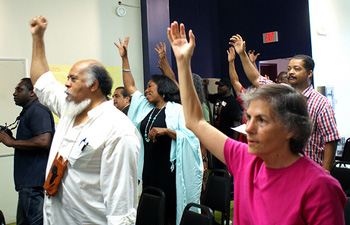 Rosalie Peterson of the Department of Neighborhood Empowerment raises her fist in the Community Issues Forum’s introductory Harambee chant. Rosalie Peterson of the Department of Neighborhood Empowerment raises her fist in the Community Issues Forum’s introductory Harambee chant. |
Moderators Carlos Montes and Dr Maulana Karenga each spoke about the history of black and Latino unity in the Americas before discussion of present community issues began. Montes, whose Chicano-Latino activism began with the Brown Berets in the 1960s, harkened to black-brown coalitions in the unified Third World fighting U.S. imperialism during the Cold War. “When we were attacked, we supported each other,” he said.
 Moderators Carlos Montes and Maulana Karenga analyze a participant’s comment before responding to his question. Moderators Carlos Montes and Maulana Karenga analyze a participant’s comment before responding to his question. |
Much of the morning’s rhetoric reflected its organizers’ backgrounds in radical and even militant activism. Karenga, chair of the African Studies department at California State University, Long Beach and creator of the pan-African holiday Kwanzaa, headed a black nationalist group that competed with the Black Panthers in the 1960s. That group, The Organization Us, maintains an office near Leimert Park.
“We struggle like this because together we will win,” said Karenga. “We are soldiers on the battlefield for something better… and we must talk often and productively with one another.”
Two participants in the South L.A. Power Coalition’s forum greet each other with a handshake and an embrace.
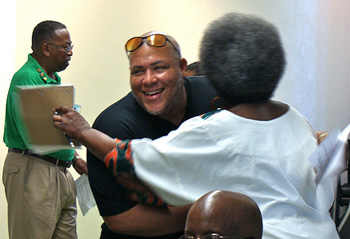 Two participants in the South L.A. Power Coalition’s forum greet each other with a handshake and an embrace. Two participants in the South L.A. Power Coalition’s forum greet each other with a handshake and an embrace. |
The community’s challenges
But cooperation is hardly as rosy as the facilitators described it in theory. Thandi Chimurenga, a freelance journalist, broached the black community’s concern that often Latino police officers, not just whites, commit violence against blacks.
Chimurenga called specifically on Latina women, addressing them as “mis hermanas,” to react to those killings in solidarity with their black neighbors.
“I need to hear a human cry from the community, and I need it to be translated into English and in Spanish. When a black person is murdered, I need to hear a human voice,” Chimurenga said. Scattered applause and encouraging murmurs followed.
In response, SLAPC member Blanca Cruz said Latinos who join the police force often become “rasa” – people who oppress their own people. “Cops… represent the oppressive system,” she said, no matter what ethnicity they claim.
Karenga hypothesized that the police department plays on historical neighborhood rivalry and uses Latinos against blacks. If so, “this is a battle strategy conversation. They’re trying to destroy our unity,” he said. “We must not let our oppressor” – that is, traditional white centers of power – “be our teacher about who we like, who we trust, or who we let across the border,” he said.
Also, reminded Montes, many in the Latino community have denounced Sheriff Lee Baca.
Another pertinent comment touched on the South Central Neighborhood’s Council recent resolution against the disproportionate rate of black student suspensions at Santee Educational Complex. Just 5 percent of Santee’s students are black, but 23 percent of them were suspended in 2011-2012, CityWatch LA reported (http://www.citywatchla.com/lead-stories/3751-blacks-and-latinos-unite-to-fight-for-reduction-in-black-student-suspensions).
Ron Gochez, a history teacher at Santee and vice president of the SCNC, addressed the problem as one of black-brown unity: rather than allowing the majority group (Latinos) to dominate the minority (blacks), both must come to a place of cultural understanding.
As a long-term remedy, Gochez proposed institutionalized ethnic studies programs in L.A. schools. Educating black and Latino students about their shared history, particularly during civil rights and labor movements, could help reduce inter-group violence and animosity.
“We need a vigorous multiculturalism, and I don’t mean food, fashion or festival,” Karenga said. “We share responsibility. We must practice reciprocal solidarity.”
Finally, thinly veiled calls to political action bubbled under the forum’s ideological surface. Two City Council candidates and a City Controller candidate addressed the crowd. But March’s election will be the first decided by new council district lines.
Black councilmembers have represented District 9, which encompasses much of South Central L.A., since 1963.
Gochez, who is running for the seat, encouraged residents to choose the person who could best represent both black and Latino residents.
Jitahidi also stressed unity in his closing remarks. District 9 cannot belong to a distinct group, he said.
“We’re not trying to be the best Democrats or the best Republicans or the best decline-to-state voters. We’re trying to kill the status quo” by continuing to elect “brave and courageous leaders,” Jitahidi said.
The SLAPC has not yet declared support for any candidate in L.A.’s March elections.
“Next time, we’ll need more time”
Long before polls open, however, the forum’s attendees must start working, Jitahidi said in his closing remarks. SLAPC officers cut off the line of attendees waiting to speak after more than 80 minutes of questions and suggestions. Still, only about a third of the forum’s participants addressed the crowd.
One of its final speakers requested monthly meetings. The crowd replied with fervent nods and a few supportive whistles.
Arnetta Mack, another organizer of the conference, affirmed these plans. “It was good for a first attempt,” she said. “Next time, we’ll need more time and more space.”
One Afro-Latina member of Karenga’s Organization Us, Hasani Soto, expressed the importance of educating community members in conversations like these. In identifying with both cultures, Hasani said she shares both groups’ knowledge and responsibilities.
“We need to study more, and not just TV or radio. We need to read more,” Soto said. “If we don’t do the studying and we don’t have the dialogue, the issues will still be there.”
Still, though, Soto was delighted by Saturday’s attempt. “It was excellent. It was beautiful,” she said.
However, Kahllid A. Al-Alim of the Park Mesa Heights Neighborhood Council warned that, to be effected, the forum needed to maintain organization.
With so many nonprofits and political activist organizations working on such a variance of issues, “This could be a case of too many cooks in the kitchen,” Al-Alim said.









.jpg)
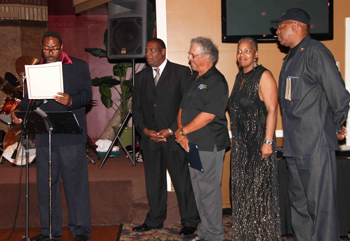 Drummer Al Williams, one of the Living Legends Linda Morgan (second from right) celebrated in April
Drummer Al Williams, one of the Living Legends Linda Morgan (second from right) celebrated in April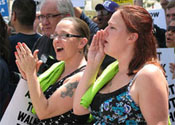 Listen to the audio story from Annenberg Radio News:
Listen to the audio story from Annenberg Radio News: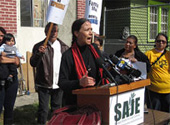 There’s a house on East Adams Boulevard in South Central Los Angeles where broken windows are covered by cardboard and wrapping paper. Cockroaches crawl in water glasses and a ratty extension cord connecting a generator to a bare fluorescent bulb is stapled to the ceiling.
There’s a house on East Adams Boulevard in South Central Los Angeles where broken windows are covered by cardboard and wrapping paper. Cockroaches crawl in water glasses and a ratty extension cord connecting a generator to a bare fluorescent bulb is stapled to the ceiling.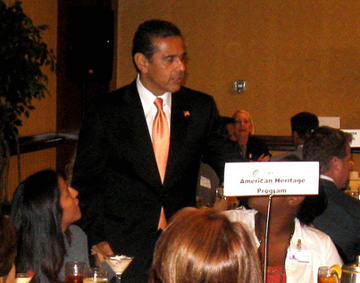 Mayor Antonio Villaraigosa conceded Tuesday that the recession has overpowered Los Angeles’ best efforts to hang onto jobs. It will likely take ten years for Los Angeles to offer the same number of jobs it did before the 2008 recession. But he’s confident in the city’s ability to capitalize in the future.
Mayor Antonio Villaraigosa conceded Tuesday that the recession has overpowered Los Angeles’ best efforts to hang onto jobs. It will likely take ten years for Los Angeles to offer the same number of jobs it did before the 2008 recession. But he’s confident in the city’s ability to capitalize in the future.




